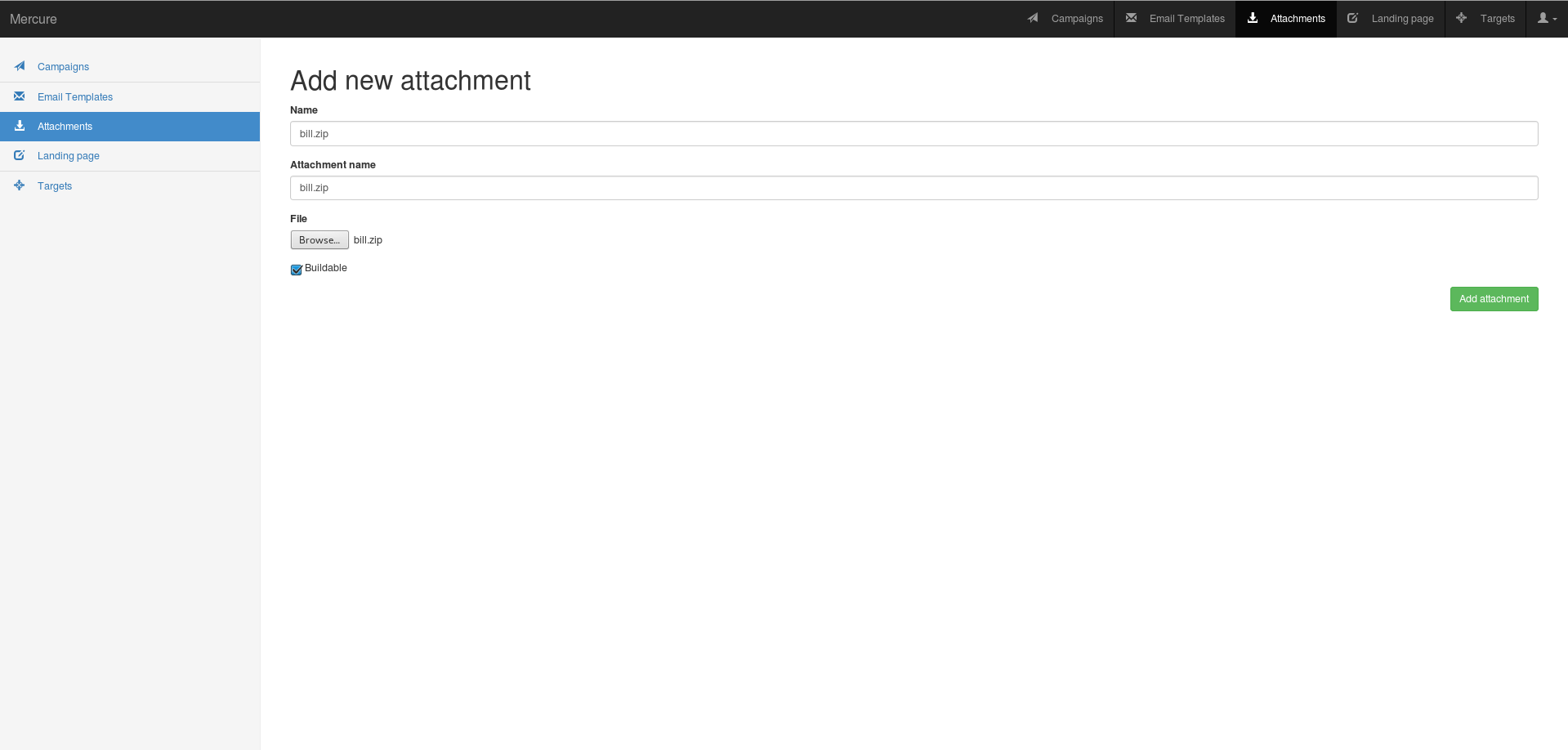Mercure is a tool for security managers who want to teach their colleagues about phishing.
- Create email templates
- Create target lists
- Create landing pages
- Handle attachments
- Let you keep track in the Campaign dashboard
- Track email reads, landing page visits and attachment execution.
- Harvest credentials
- Schedule campaigns
- Minimize link in email templates
- Display more graphs (we like graphs!)
- Provide a REST API
- Allow for multi-message campaigns (aka scenarios)
- Check browser plugins
- User training
- docker
- docker-compose
| Environment variable name | Status | Description | Value example |
|---|---|---|---|
| SECRET_KEY | Required | Django secret key | Random string |
| URL | Required | Mercure URL | https://mercure.example.com |
| EMAIL_HOST | Required | SMTP server | mail.example.com |
| EMAIL_PORT | Optional | SMTP port | 587 |
| EMAIL_HOST_USER | Optional | SMTP user | phishing@example.com |
| EMAIL_HOST_PASSWORD | Optional | SMTP password | P@SSWORD |
| DEBUG | Optional | Run on debug mode | True |
| SENTRY_DSN | Optional | Send debug info to sentry.io | https://23xxx:38xxx@sentry.io/1234 |
| AXE_DISABLED | Optional | Forcebrute protection is disabled | True |
| AXES_LOCK_OUT_AT_FAILURE | Optional | Ban on forcebrute login | True |
| AXES_COOLOFF_TIME | Optional | Ban duration on forcebrute login (in hours) | 0.8333 |
| DONT_SERVES_STATIC_FILE | Optional | Don't serve static files with django | True |
Edit docker compose configuration (docker-compose.yml)
version: '2'
services:
front:
image: atexio/mercure
restart: always
ports:
- 8000:8000
environment:
SECRET_KEY: '<random value>'
URL: 'https://preprod.mercure.io'
EMAIL_HOST: 'mail.example.com'
EMAIL_HOST_USER: 'phishing@example.com'
EMAIL_HOST_PASSWORD: 'P@SSWORD'
volumes:
- /etc/localtime:/etc/localtime:ro
- ./data/database:/code/database
- ./data/media:/code/media
- ./data/migrations/phishing:/code/phishing/migrations
To generate the SECRET_KEY variable, you can use this command:
# generate random SECRET_KEY
cat /dev/urandom | tr -dc 'a-zA-Z0-9' | fold -w 200 | head -n 1The SECRET_KEY is used as a salt for django password hashing, don't change it after using it with mercure. After changing the secret key, you can run the container with this command:
docker-compose up -dNext, you can create a super user to log into web interface:
# create super user
docker-compose exec front python manage.py createsuperuserWe can consider mercure is divided into 5 steps :
- Targets
- Email Templates
- Campaigns
- Attachments
- Landing page
Targets, Email Templates and Campaign are the minimum required to run a basic phishing campaign.
-
First, add your targets
You need to fill mercure name, the target email.Target first and last name are optional, but can be usefull to the landing page
-
Then, fill the email template.
You need to fill the mercure name, the subject, the send and the email content. To improve the email quality, you have to fill the email content HTML and the text content. To get information about opened email, check "Add open email tracker" You can be helped with "Variables" category.
Attachments and landing page are optionnal, we will see it after.
-
Finally, launch the campaign
You need to fill the mercure name, select the email template and the target group. You can select the SMTP credentials, SSL using or URL minimazing
-
Optional, add landing page
You need to fill the mercure name, the domain to use You can use "Import from URL" to copy an existing website.
You have to fill the page content with text and HTML content by clicking to "Source"
-
Optional, add Attachment
You need to fill the mercure name, the file name which appears in the email and the file You also have to check if the the file is buildable or not, if you need to compute a file for example.
To execute the build , you need to create a zip archive which contain a build script (named 'generator.sh' and a buildable file
-
Fork the project
-
Create new branch
-
Make comments and clean commits to the repository
-
Run unnittests
python manage.py test --exclude-tag selenium -
Perform a pull request
We want to keep Mercure safe for everyone. If you've discovered a security vulnerability in Mercure, we appreciate your help in disclosing it to us in a responsible manner.
Send an email to 'security@atexio.fr'. If you want, you can use with PGP Key
- Name of the vulnerability
- Attack Vector (AV)
- Attack Complexity (AC)
- Privileges Required (PR)
- User Interaction (UI)
- Scope (S)
- Confidentiality (C)
- Integrity (I)
- Availability (A)
- Your Name
- Your Mail
- Your PGP public key
- More technical details.




